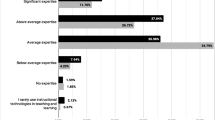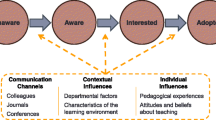Abstract
Teachers’ implementation of technology-enhanced student-centered learning environments (SCLEs) will be affected by their beliefs about effective practices. In order for student-centered programs to be used as intended, designers must be aware of the key issues that will shape their implementation and the beliefs teachers hold about these issues. This case study examined 15 teachers’ beliefs about student-centered learning as they implemented Alien Rescue, a computer-based program for middle school science that was designed to create a SCLE in the classroom. Considerations for the design of similar programs are offered.
Similar content being viewed by others
References
Bandura, A. (1986).Social foundations of thought and action: A social cognitive theory. Englewood Cliffs, NJ: Prentice-Hall.
Barab, S.A., Hay, K.E., & Duffy, T.M. (2000).Grounded constructions and how technology can help. Retrieved July 20, 2002, from http://crlt.indiana.edu/publications/tr_12_00.pdf
Behrens, J.R., & Smith, M.L. (1996). Data and data analysis. In D.H. Jonassen (Ed.),Handbook of research for educational communications and technology (pp. 945–989). New York: Simon & Schuster Macmillan.
Brickhouse, N.W. (1990). Teachers’ beliefs about the nature of science and their relationship to classroom practice.Journal of Teacher Education, 41(3), 53–62.
Bruffee, K.A. (1995). Sharing our toys: Cooperative learning versus collaborative learning.Change, 27(1), 12–18.
Brush, T., & Saye, J. (2000). Implementation and evaluation of a student-centered learning unit: A case study.Educational Technology Research and Development, 48(3), 79–100.
Butler, R., & Nisan, M. (1986). Effects of no feedback, task-related comments, and grades on intrinsic motivation and performance.Journal of Educational Psychology, 78(3), 210–216.
Cuban, L. (1982). Persistence of the inevitable: The teacher centered classroom.Education and Urban Society, 15(1), 26–41.
Cuban, L. (1983). How did teachers teach, 1890–1980.Theory into Practice, 22(3), 159–165.
Eisenhart, M.A., Shrum, J.L., Harding, J.R., & Cuthbert, A.M. (1988). Teacher beliefs: Definitions, findings, and directions.Educational Policy, 2(1), 51–70.
Ertmer, P.A. (1999). Addressing first- and second-order barriers to change: Strategies for technology integration.Educational Technology Research and Development, 47(4), 47–61.
Fang, Z. (1996). A review of research on teacher beliefs and practices.Educational Research, 38(1), 47–65.
Guskey, T.R. (1986). Staff development and the process of teacher change.Educational Researcher, 5–12.
Hannafin, M., & Land, S.M. (2000). Technology and student-centered learning in higher education: Issues and practices.Journal of Computing in Higher Education, 12(1), 3–30.
Hannafin, M., Land, S.M., & Oliver, K. (1999). Open learning environments: Foundations, methods, and models. In C.M. Reigeluth (Ed.),Instructional-Design Theories and Models (Vol. II, pp. 115–140). Mahwah, New Jersey: Lawrence Erlbaum Associates.
Harter, S. (1978). Pleasure derived from challenge and the effects of receiving grades on children’s difficulty level choices.Child Development, 49, 788–799.
Hedberg, J. (1997, April). Employing cognitive tools within interactive multimedia applications. Paper presented at the annual meeting of the Association for Educational Communications and Technology, Albuquerque, NM.
Jonassen, D.H. (1997). Instructional design models for well-structured and ill-structured problem-solving learning outcomes.Educational Technology Research and Development, 45(1), 65–94.
Jonassen, D.H. (1999). Designing constructivist learning environments. In C.M. Reigeluth (Ed.),Instructional-Design Theories and Models (Vol. II, pp. 215–239). Mahwah, New Jersey: Lawrence Erlbaum Associates.
Jonassen, D.H. (2000). Revisiting activity theory as a framework for designing student-centered learning environments. In D.H. Jonassen & S.M. Land (Eds.),Theoretical Foundations of Learning Environments (pp. 89–121). Mahwah, New Jersey: Lawrence Erlbaum Associates.
Kohn, A. (1994, October). Grading: The issue is not how but why.Educational Leadership, 38–41.
Land, S.M., & Hannafin, M.J. (2000). Student-centered learning environments. In D.H. Jonassen & S.M. Land (Eds.),Theoretical Foundations of Learning Environments (pp. 1–23). Mahwah, New Jersey: Lawrence Erlbaum Associates.
Lincoln, Y., & Guba, E. (1985).Naturalistic inquiry. Newbury Park, California: Sage Publications.
Lumpe, A.T., Haney, J.J., & Czerniak, C.M. (1998). Science teacher beliefs and intentions to implement science-technology-society (STS) in the classroom.Journal of Science Teacher Education, 9(1), 1–24.
Lumpe, A.T., Haney, J.J., & Czerniak, C.M. (2000). Assessing teachers’ beliefs about their science teaching context.Journal of Research in Science Teaching, 37(3), 275–292.
Manning, M.L. (2000). Child-centered middle schools: A position paper.Childhood Education, 76(3), 154–159.
National Center for Educational Statistics. (1999).What happens in classrooms? Instructional practices in elementary and secondary schools 1994–95 (NCES 1999-348). Retrieved December 15, 2002, from http://nces.ed.gov/pubs99/1999348.pdf
Nespor, J. (1987). The role of beliefs in the practice of teaching.Journal of Curriculum Studies, 18, 197–206.
Pajares, M.F. (1992). Teachers’ beliefs and educational research: Cleaning up a messy construct.Review of Educational Research, 62(3), 307–332.
Pedersen, S. (2003). Motivational orientation in a problem-based learning environment.Journal of Interactive Learning Research, 14(1), 51–77.
Richardson, V. (1990). Significant and worthwhile change in teaching practice.Educational Researcher, 19(7), 10–18.
Rokeach, M. (1968).Beliefs, attitudes, and values: A theory of organization and change. San Francisco: Jossey-Bass.
Schommer, M., Calvert, C., Gariglietti, G., & Bajaj, A. (1997). The development of epistemological beliefs among secondary students: A longitudinal study.Journal of Educational Psychology, 89(1), 37–40.
Shepard, L.A. (2000). The role of assessment in a learning culture.Educational Researcher, 29(7), 4–14.
Tobin, K., Tippins, D.J., & Gallard, A.J. (1994). Research on instructional strategies for teaching science. In D.J. Gabel (Ed.),Handbook of research on science teaching and learning (pp. 45–93). New York: Macmillan.
Tom Snyder Productions. (2003). The Great Ocean Rescue [Computer software]. Watertown, MA.
Williams, S.M. (1993). Putting case based learning into context: Examples from legal, business, and medical education.Journal of the Learning Sciences, 2, 367–427.
Windschitl, M. (2002). Framing constructivism in practice as the negotiation of dilemmas: An analysis of the conceptual, pedagogical, cultural, and political challenges facing teachers.Review of Educational Research, 72(2), 131–175.
Author information
Authors and Affiliations
Rights and permissions
About this article
Cite this article
Pedersen, S., Liu, M. Teachers’ beliefs about issues in the implementation of a student-centered learning environment. ETR&D 51, 57–76 (2003). https://doi.org/10.1007/BF02504526
Issue Date:
DOI: https://doi.org/10.1007/BF02504526




